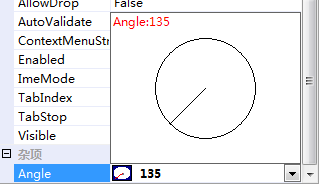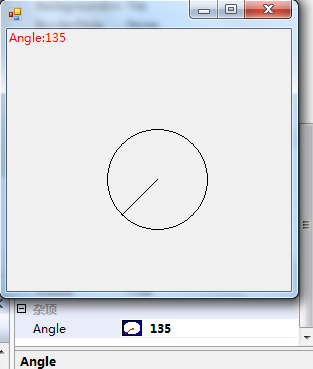零.引言
PropertyGrid中我们经常看到一些下拉式的编辑方式(Color属性)和弹出式编辑框(字体),这些都是为一些复杂的属性提供的编辑方式,本文主要说明如何实现这样的编辑方式。
一.为属性提供编辑类
弹出式和下拉式是如何实现的呢,这需要为属性提供一个专门的编辑类。.Net为我们提供了一个System.Drawing.Design.UITypeEditor类,它是所有编辑类的基类,从他继承出了诸如ColorEditor、FontEditor的类,因此我们可以在属性框中编辑颜色和字体。定义了这样的类,我们也可以为自己的属性实现弹出式和下拉式编辑方式。
先看一下MSDN中对UITypeEditor的介绍:提供可用于设计值编辑器的基类,这些编辑器可提供用户界面 (UI),用来表示和编辑所支持的数据类型的对象值。
UITypeEditor 类提供一种基类,可以从该基类派生和进行扩展,以便为设计时环境实现自定义类型编辑器。通常,您的自定义类型编辑器与 PropertyGrid 控件进行交互。在文本框值编辑器不足以有效地选择某些类型的值的情况下,自定义类型编辑器非常有用。
继承者说明:
若要实现自定义设计时 UI 类型编辑器,必须执行下列步骤:
- 定义一个从 UITypeEditor 派生的类。
- 重写 EditValue 方法以处理用户界面、用户输入操作以及值的分配。
- 重写 GetEditStyle 方法,以便将编辑器将使用的编辑器样式的类型通知给“属性”窗口。
通过执行下列步骤,可以为在“属性”窗口中绘制值的表示形式添加附加支持:
- 重写 GetPaintValueSupported 方法以指示编辑器支持显示值的表示形式。
- 重写 PaintValue 方法以实现该值的表示形式的显示。
- 如果编辑器应具有初始化行为,则重写 UITypeEditor 构造函数方法。
二.下拉式编辑方式
接下来我们来实现下拉式编辑方式,接下来举一个具体的例子来说明。
首先假如我们有一个控件类MyControl:
public class MyControl : System.Windows.Forms.UserControl { private double _angle; [BrowsableAttribute(true)] public double Angle { get { return _angle; } set { _angle = value; } } public MyControl() { this._angle = 90; } protected override void OnPaint(System.Windows.Forms.PaintEventArgs e) { e.Graphics.DrawString("The Angle is " + _angle, this.Font, Brushes.Red,0,0); } }
其中有个属性Angle,我们要为其提供下拉式和弹出式编辑方式,当然了,一般都是较为复杂的属性才需要,这里只是为了举例说明。
我们为其设计一个编辑类AngleEditor,在第二节中,继承说明中的第一条和第二条,EditValue和GetEditStyle两个函数,这是必须要重写的:

[System.Security.Permissions.PermissionSet(System.Security.Permissions.SecurityAction.Demand, Name = "FullTrust")] public class AngleEditor : System.Drawing.Design.UITypeEditor { public AngleEditor() { } //下拉式还是弹出式 public override System.Drawing.Design.UITypeEditorEditStyle GetEditStyle(System.ComponentModel.ITypeDescriptorContext context) { return UITypeEditorEditStyle.DropDown; } // 为属性显示UI编辑框 public override object EditValue(System.ComponentModel.ITypeDescriptorContext context, System.IServiceProvider provider, object value) { //值类型不为double,直接返回value if (value.GetType() != typeof(double)) return value; //值为double,显示下拉式或弹出编辑框 IWindowsFormsEditorService edSvc = (IWindowsFormsEditorService)provider.GetService(typeof(IWindowsFormsEditorService)); if (edSvc != null) { // 显示编辑框并初始化编辑框的值 AngleControl angleControl = new AngleControl((double)value); edSvc.DropDownControl(angleControl); // 返回编辑框中编辑的值. if (value.GetType() == typeof(double)) return angleControl.angle; } return value; } //下面两个函数是为了在PropertyGrid中显示一个辅助的效果 //可以不用重写 public override void PaintValue(System.Drawing.Design.PaintValueEventArgs e) { int normalX = (e.Bounds.Width / 2); int normalY = (e.Bounds.Height / 2); e.Graphics.FillRectangle(new SolidBrush(Color.DarkBlue), e.Bounds.X, e.Bounds.Y, e.Bounds.Width, e.Bounds.Height); e.Graphics.FillEllipse(new SolidBrush(Color.White), e.Bounds.X + 1, e.Bounds.Y + 1, e.Bounds.Width - 3, e.Bounds.Height - 3); e.Graphics.FillEllipse(new SolidBrush(Color.SlateGray), normalX + e.Bounds.X - 1, normalY + e.Bounds.Y - 1, 3, 3); double radians = ((double)e.Value * Math.PI) / (double)180; e.Graphics.DrawLine(new Pen(new SolidBrush(Color.Red), 1), normalX + e.Bounds.X, normalY + e.Bounds.Y, e.Bounds.X + (normalX + (int)((double)normalX * Math.Cos(radians))), e.Bounds.Y + (normalY + (int)((double)normalY * Math.Sin(radians)))); } public override bool GetPaintValueSupported(System.ComponentModel.ITypeDescriptorContext context) { return true; } } // 这里是我们要显示出来的编辑器,把它作为一个内置类 //从UserControl继承,要在上面EditValue函数中使用的 internal class AngleControl : System.Windows.Forms.UserControl { public double angle; //编辑的角度 private float x; //鼠标位置 private float y; public AngleControl(double initial_angle) { this.angle = initial_angle; } //显现时,显示属性的当前值 protected override void OnLoad(EventArgs e) { int originX = (this.Width / 2); int originY = (this.Height / 2); this.x = (float)(50 * Math.Cos(this.angle * Math.PI / 180) + originX); this.y = (float)(50 * Math.Sin(this.angle * Math.PI / 180) + originY); base.OnLoad(e); } //绘制控件,用来显示编辑角度 protected override void OnPaint(System.Windows.Forms.PaintEventArgs e) { int originX = (this.Width / 2); int originY = (this.Height / 2); e.Graphics.DrawEllipse(Pens.Black, originX - 50, originY - 50, 100, 100); e.Graphics.DrawLine(Pens.Black, originX, originY, x, y); e.Graphics.DrawString("Angle:" + this.angle, this.Font, Brushes.Red, 0, 0); } //鼠标移动时设置角度 protected override void OnMouseMove(System.Windows.Forms.MouseEventArgs e) { if (e.Button == MouseButtons.Left) { int originX = (this.Width / 2); int originY = (this.Height / 2); double len = Math.Sqrt(Math.Pow(e.X - originX, 2) + Math.Pow(e.Y - originY, 2)); double h = e.Y - originY; this.angle = Math.Asin(h / len); if ((e.X >= originX && e.Y >= originY)) { this.x = (float)(50 * Math.Cos(this.angle) + originX); this.y = (float)(50 * Math.Sin(this.angle) + originY); this.angle = this.angle * 180 / Math.PI; } else if (e.X < originX && e.Y > originY) { this.x = (float)(originX - 50 * Math.Cos(this.angle)); this.y = (float)(50 * Math.Sin(this.angle) + originY); this.angle = 180 - this.angle * 180 / Math.PI; } else if (e.X < originX && e.Y < originY) { this.x = (float)(originX - 50 * Math.Cos(this.angle)); this.y = (float)(originY + 50 * Math.Sin(this.angle)); this.angle = 180 - this.angle * 180 / Math.PI; } else if (e.X >= originX && e.Y <= originY) { this.x = (float)(originX + 50 * Math.Cos(this.angle)); this.y = (float)(originY + 50 * Math.Sin(this.angle)); this.angle = 360 + this.angle * 180 / Math.PI; } this.Invalidate(); } } }
这里有两个类,一个是AngleEditor,他就是我们要用于到属性特性中的编辑类,一个是AngleControl,他是辅助AngleEditor来编辑属性的,也就是说,他就是一个form,当我们编辑属性时,他会显现出来,供我们编辑属性值,可以是textBox,图形,表格,各种方式,只需要最后他返回编辑好的属性值给AngleEditor类。在AngleEditor类中的EditValue函数中,我们会调用AngleControl类,并接受它返回的值。
设计好编辑类后,把它应用到MyControl类中的Angle属性中,在Angle属性中增加特性[EditorAttribute(typeof(AngleEditor), typeof(System.Drawing.Design.UITypeEditor))],相当于告诉PropertyGrid我们要用AngleEditor来编辑这个属性。
[BrowsableAttribute(true)] [EditorAttribute(typeof(AngleEditor), typeof(System.Drawing.Design.UITypeEditor))] public double Angle { get { return _angle; } set { _angle = value; } }
好了,现在就可以使用下拉框来编辑我们的Angle属性了,效果如下:

上面那个圆圈就是我们用来编辑角度的。
三.弹出式编辑方式
实现了下拉式,我们来实现弹出式,弹出式和下拉式非常的相像,现在要弹出一个编辑框,因此我们的AngleControl类不能从UserControl继承,而从From继承,让他成为一个对话框,在AngleEditor的EditValue函数中,弹出他并接受返回值,如下:

[System.Security.Permissions.PermissionSet(System.Security.Permissions.SecurityAction.Demand, Name = "FullTrust")] public class AngleEditor : System.Drawing.Design.UITypeEditor { public AngleEditor() { } //下拉式还是弹出式 public override System.Drawing.Design.UITypeEditorEditStyle GetEditStyle(System.ComponentModel.ITypeDescriptorContext context) { return UITypeEditorEditStyle.Modal;//弹出式 } // 为属性显示UI编辑框 public override object EditValue(System.ComponentModel.ITypeDescriptorContext context, System.IServiceProvider provider, object value) { //值类型不为double,直接返回value if (value.GetType() != typeof(double)) return value; //值为double,显示下拉式或弹出编辑框 IWindowsFormsEditorService edSvc = (IWindowsFormsEditorService)provider.GetService(typeof(IWindowsFormsEditorService)); if (edSvc != null) { // 显示编辑框并初始化编辑框的值 AngleControl2 angleControl = new AngleControl2((double)value); edSvc.ShowDialog(angleControl); // 返回编辑框中编辑的值. if (value.GetType() == typeof(double)) return angleControl.angle; } return value; } //下面两个函数是为了在PropertyGrid中显示一个辅助的效果 //可以不用重写 public override void PaintValue(System.Drawing.Design.PaintValueEventArgs e) { int normalX = (e.Bounds.Width / 2); int normalY = (e.Bounds.Height / 2); e.Graphics.FillRectangle(new SolidBrush(Color.DarkBlue), e.Bounds.X, e.Bounds.Y, e.Bounds.Width, e.Bounds.Height); e.Graphics.FillEllipse(new SolidBrush(Color.White), e.Bounds.X + 1, e.Bounds.Y + 1, e.Bounds.Width - 3, e.Bounds.Height - 3); e.Graphics.FillEllipse(new SolidBrush(Color.SlateGray), normalX + e.Bounds.X - 1, normalY + e.Bounds.Y - 1, 3, 3); double radians = ((double)e.Value * Math.PI) / (double)180; e.Graphics.DrawLine(new Pen(new SolidBrush(Color.Red), 1), normalX + e.Bounds.X, normalY + e.Bounds.Y, e.Bounds.X + (normalX + (int)((double)normalX * Math.Cos(radians))), e.Bounds.Y + (normalY + (int)((double)normalY * Math.Sin(radians)))); } public override bool GetPaintValueSupported(System.ComponentModel.ITypeDescriptorContext context) { return true; } } // 这里是我们要显示出来的编辑器,把它作为一个内置类 //从UserControl继承,要在上面EditValue函数中使用的 internal class AngleControl2 : System.Windows.Forms.Form { public double angle; //编辑的角度 private float x; //鼠标位置 private float y; public AngleControl(double initial_angle) { this.angle = initial_angle; } //显现时,显示属性的当前值 protected override void OnLoad(EventArgs e) { int originX = (this.Width / 2); int originY = (this.Height / 2); this.x = (float)(50 * Math.Cos(this.angle * Math.PI / 180) + originX); this.y = (float)(50 * Math.Sin(this.angle * Math.PI / 180) + originY); base.OnLoad(e); } //绘制控件,用来显示编辑角度 protected override void OnPaint(System.Windows.Forms.PaintEventArgs e) { int originX = (this.Width / 2); int originY = (this.Height / 2); e.Graphics.DrawEllipse(Pens.Black, originX - 50, originY - 50, 100, 100); e.Graphics.DrawLine(Pens.Black, originX, originY, x, y); e.Graphics.DrawString("Angle:" + this.angle, this.Font, Brushes.Red, 0, 0); } //鼠标移动时设置角度 protected override void OnMouseMove(System.Windows.Forms.MouseEventArgs e) { if (e.Button == MouseButtons.Left) { int originX = (this.Width / 2); int originY = (this.Height / 2); double len = Math.Sqrt(Math.Pow(e.X - originX, 2) + Math.Pow(e.Y - originY, 2)); double h = e.Y - originY; this.angle = Math.Asin(h / len); if ((e.X >= originX && e.Y >= originY)) { this.x = (float)(50 * Math.Cos(this.angle) + originX); this.y = (float)(50 * Math.Sin(this.angle) + originY); this.angle = this.angle * 180 / Math.PI; } else if (e.X < originX && e.Y > originY) { this.x = (float)(originX - 50 * Math.Cos(this.angle)); this.y = (float)(50 * Math.Sin(this.angle) + originY); this.angle = 180 - this.angle * 180 / Math.PI; } else if (e.X < originX && e.Y < originY) { this.x = (float)(originX - 50 * Math.Cos(this.angle)); this.y = (float)(originY + 50 * Math.Sin(this.angle)); this.angle = 180 - this.angle * 180 / Math.PI; } else if (e.X >= originX && e.Y <= originY) { this.x = (float)(originX + 50 * Math.Cos(this.angle)); this.y = (float)(originY + 50 * Math.Sin(this.angle)); this.angle = 360 + this.angle * 180 / Math.PI; } this.Invalidate(); } } }
可以看到,只修改了三个地方:
- AngleEditor类中GetEditStyle函数返回Modal,表明是以弹出式编辑。
- AngleEditor类中EditValue函数中调用编辑控件的方式:
AngleControl2 angleControl = new AngleControl2((double)value);
edSvc.ShowDialog(angleControl);
3.AngleControl2从Form继承,让他显示为对话框,这里为了区别上面的AngleControl类,将其改成了AngleControl2。
现在看看效果:

实现了弹出式的编辑方式。
四.完整代码
下面是完整的代码:
using System; using System.ComponentModel; using System.Drawing; using System.Drawing.Design; using System.Windows.Forms; using System.Windows.Forms.Design; namespace TestUITypeEditor { //编辑器类 [System.Security.Permissions.PermissionSet(System.Security.Permissions.SecurityAction.Demand, Name = "FullTrust")] public class AngleEditor : System.Drawing.Design.UITypeEditor { public AngleEditor() { } //下拉式还是弹出式 public override System.Drawing.Design.UITypeEditorEditStyle GetEditStyle(System.ComponentModel.ITypeDescriptorContext context) { return UITypeEditorEditStyle.DropDown; //return UITypeEditorEditStyle.Modal; } //编辑属性值 public override object EditValue(System.ComponentModel.ITypeDescriptorContext context, System.IServiceProvider provider, object value) { if (value.GetType() != typeof(double)) return value; //显示编辑框 IWindowsFormsEditorService edSvc = (IWindowsFormsEditorService)provider.GetService(typeof(IWindowsFormsEditorService)); if (edSvc != null) { AngleControl angleControl = new AngleControl((double)value); edSvc.DropDownControl(angleControl); //AngleControl2 angleControl = new AngleControl2((double)value); //edSvc.ShowDialog(angleControl); // 获取返回值 if (value.GetType() == typeof(double)) return angleControl.angle; } return value; } //绘制辅助属性显示 public override void PaintValue(System.Drawing.Design.PaintValueEventArgs e) { int normalX = (e.Bounds.Width / 2); int normalY = (e.Bounds.Height / 2); e.Graphics.FillRectangle(new SolidBrush(Color.DarkBlue), e.Bounds.X, e.Bounds.Y, e.Bounds.Width, e.Bounds.Height); e.Graphics.FillEllipse(new SolidBrush(Color.White), e.Bounds.X + 1, e.Bounds.Y + 1, e.Bounds.Width - 3, e.Bounds.Height - 3); e.Graphics.FillEllipse(new SolidBrush(Color.SlateGray), normalX + e.Bounds.X - 1, normalY + e.Bounds.Y - 1, 3, 3); double radians = ((double)e.Value * Math.PI) / (double)180; e.Graphics.DrawLine(new Pen(new SolidBrush(Color.Red), 1), normalX + e.Bounds.X, normalY + e.Bounds.Y, e.Bounds.X + (normalX + (int)((double)normalX * Math.Cos(radians))), e.Bounds.Y + (normalY + (int)((double)normalY * Math.Sin(radians)))); } //使用辅助属性显示 public override bool GetPaintValueSupported(System.ComponentModel.ITypeDescriptorContext context) { return true; } } // 下拉式编辑方式 internal class AngleControl : System.Windows.Forms.UserControl { public double angle; private float x; private float y; public AngleControl(double initial_angle) { this.angle = initial_angle; } protected override void OnLoad(EventArgs e) { int originX = (this.Width / 2); int originY = (this.Height / 2); this.x = (float)(50 * Math.Cos(this.angle * Math.PI / 180) + originX); this.y = (float)(50 * Math.Sin(this.angle * Math.PI / 180) + originY); base.OnLoad(e); } protected override void OnPaint(System.Windows.Forms.PaintEventArgs e) { int originX = (this.Width / 2); int originY = (this.Height / 2); e.Graphics.DrawEllipse(Pens.Black, originX - 50, originY - 50, 100, 100); e.Graphics.DrawLine(Pens.Black, originX, originY, x, y); e.Graphics.DrawString("Angle:" + this.angle, this.Font, Brushes.Red, 0, 0); } protected override void OnMouseMove(System.Windows.Forms.MouseEventArgs e) { if (e.Button == MouseButtons.Left) { int originX = (this.Width / 2); int originY = (this.Height / 2); double len = Math.Sqrt(Math.Pow(e.X - originX, 2) + Math.Pow(e.Y - originY, 2)); double h = e.Y - originY; this.angle = Math.Asin(h / len); if ((e.X >= originX && e.Y >= originY)) { this.x = (float)(50 * Math.Cos(this.angle) + originX); this.y = (float)(50 * Math.Sin(this.angle) + originY); this.angle = this.angle * 180 / Math.PI; } else if (e.X < originX && e.Y > originY) { this.x = (float)(originX - 50 * Math.Cos(this.angle)); this.y = (float)(50 * Math.Sin(this.angle) + originY); this.angle = 180 - this.angle * 180 / Math.PI; } else if (e.X < originX && e.Y < originY) { this.x = (float)(originX - 50 * Math.Cos(this.angle)); this.y = (float)(originY + 50 * Math.Sin(this.angle)); this.angle = 180 - this.angle * 180 / Math.PI; } else if (e.X >= originX && e.Y <= originY) { this.x = (float)(originX + 50 * Math.Cos(this.angle)); this.y = (float)(originY + 50 * Math.Sin(this.angle)); this.angle = 360 + this.angle * 180 / Math.PI; } this.Invalidate(); } } } //弹出式编辑框 internal class AngleControl2 : System.Windows.Forms.Form { public double angle; private float x; private float y; public AngleControl2(double initial_angle) { this.angle = initial_angle; } protected override void OnLoad(EventArgs e) { int originX = (this.Width / 2); int originY = (this.Height / 2); this.x = (float)(50 * Math.Cos(this.angle * Math.PI / 180) + originX); this.y = (float)(50 * Math.Sin(this.angle * Math.PI / 180) + originY); base.OnLoad(e); } protected override void OnPaint(System.Windows.Forms.PaintEventArgs e) { int originX = (this.Width / 2); int originY = (this.Height / 2); e.Graphics.DrawEllipse(Pens.Black, originX - 50, originY - 50, 100, 100); e.Graphics.DrawLine(Pens.Black, originX, originY, x, y); e.Graphics.DrawString("Angle:" + this.angle, this.Font, Brushes.Red, 0, 0); } protected override void OnMouseMove(System.Windows.Forms.MouseEventArgs e) { if (e.Button == MouseButtons.Left) { int originX = (this.Width / 2); int originY = (this.Height / 2); double len = Math.Sqrt(Math.Pow(e.X - originX, 2) + Math.Pow(e.Y - originY, 2)); double h = e.Y - originY; this.angle = Math.Asin(h / len); if ((e.X >= originX && e.Y >= originY)) { this.x = (float)(50 * Math.Cos(this.angle) + originX); this.y = (float)(50 * Math.Sin(this.angle) + originY); this.angle = this.angle * 180 / Math.PI; } else if (e.X < originX && e.Y > originY) { this.x = (float)(originX - 50 * Math.Cos(this.angle)); this.y = (float)(50 * Math.Sin(this.angle) + originY); this.angle = 180 - this.angle * 180 / Math.PI; } else if (e.X < originX && e.Y < originY) { this.x = (float)(originX - 50 * Math.Cos(this.angle)); this.y = (float)(originY + 50 * Math.Sin(this.angle)); this.angle = 180 - this.angle * 180 / Math.PI; } else if (e.X >= originX && e.Y <= originY) { this.x = (float)(originX + 50 * Math.Cos(this.angle)); this.y = (float)(originY + 50 * Math.Sin(this.angle)); this.angle = 360 + this.angle * 180 / Math.PI; } this.Invalidate(); } } } //控件 public class MyControl : System.Windows.Forms.UserControl { private double _angle; [BrowsableAttribute(true)] [EditorAttribute(typeof(AngleEditor), typeof(System.Drawing.Design.UITypeEditor))] public double Angle { get { return _angle; } set { _angle = value; } } public MyControl() { this._angle = 90; } protected override void OnPaint(System.Windows.Forms.PaintEventArgs e) { e.Graphics.DrawString("The Angle is " + _angle, this.Font, Brushes.Red,0,0); } } }
新建Window工程,添加该文件,在工具箱中将MyControl控件拖入Form,在属性框中编辑Angle属性。
这里我们把AngleControl和AngleControl2都集成在里面了,当然实际只需选中一种,要实现弹出式,只需按照(三)中的方法,修改AngleEditor中两个地方即可。
(原文)
